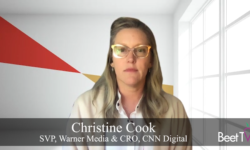The COVID-19 pandemic has been extremely difficult for publishers, with many advertising buyers using keyword blocking tools to swerve virus-related stories, or simply stopping advertising in news altogether.
But publishers may be able to soften the blow and give advertisers what they want by using their own tools.
In this video interview with Beet.TV, Chance Johnson, chief revenue officer of Integral Ad Science (IAS), says: “For publishers specifically, we’ve created tools that will allow them to proactively target ads and inventory away from particular advertisers that are sensitive to a specific piece of content.
“It’s allowing them to curate their ads and optimize their ads in a way that is going to drive the most yield, allow them to monetize the most impressions and, most importantly, avoid any unnecessary blocking of ads.”
Context is king
Johnson advocates the use of “cognitive semantic technology”, which can peer deep in to the inner meaning of content, making it available as richer indicators to buy ads against.
That is part of the growth of “contextual” ad targeting.
In November, IAS acquired ADmantX, whose semantic analysis software aims to create, from stories, corresponding flags for emotions and sentiments, plus for entities contained in stories, which can be leveraged by media buyers and sellers.
“There’s a very big difference between a story that’s talking about something negative like the increased risk of increased death toll if we open states too early, versus a really positive and uplifting story about a frontline medical workers and the sacrifices they’re making,” Johnson adds.
“Our responsibility is to give our customers the ability to make that distinction, and align against the content that they feel is right for their particular brand.”
Audiences attracted to COVID-19
But audience research is piling up that shows advertisers perhaps don’t need to dodge coronavirus news at all. An April study conducted by IAS found:
- A 12% growth in consumers seeking out coronavirus content online
- 75% of consumers were actively seeking out news online, that’s 16% up from March, a huge jump.
- And there was a 27% growth in consumers actively seeking out news content
due to coronavirus situation. - 28% of consumers said they were unlikely to engage with an ad against coronavirus content.
- But a vast majority said that adjacency would not change their opinion of a brand.
Consumers’ views seem at odds with those of brands. In a March marketer survey from IAS:
- 61% of marketers said that the coronavirus situation is changing the types of content they are comfortable advertising alongside
- 49% of marketers said the they would be “concerned” if their ad appeared near coronavirus content online.
Safety versus suitability
Still, IAS’ Johnson understands brands’ quest for appropriate environments. He just see s distinction between the idea of “brand safety” and what he calls “brand suitability”.
He says “brand safety” is a binary concept, wherein advertisers will want to swerve content like hate speech or adult material. But “brand suitability” is more nuanced and, so requires a deeper understanding of content.
“The current economic and pandemic situation that we’re in, it’s certainly accelerated the adoption of brand suitability for a number of different reasons,” Johnson says.
“We’ve seen increased demand. We expect that to continue, especially as advertisers get much more focused and refining and getting precise about what’s appropriate for them.”
This video is part of a series titled Brand Suitability at the Forefront, presented by Integral Ad Science. For more segments from the series, please visit this page.








































